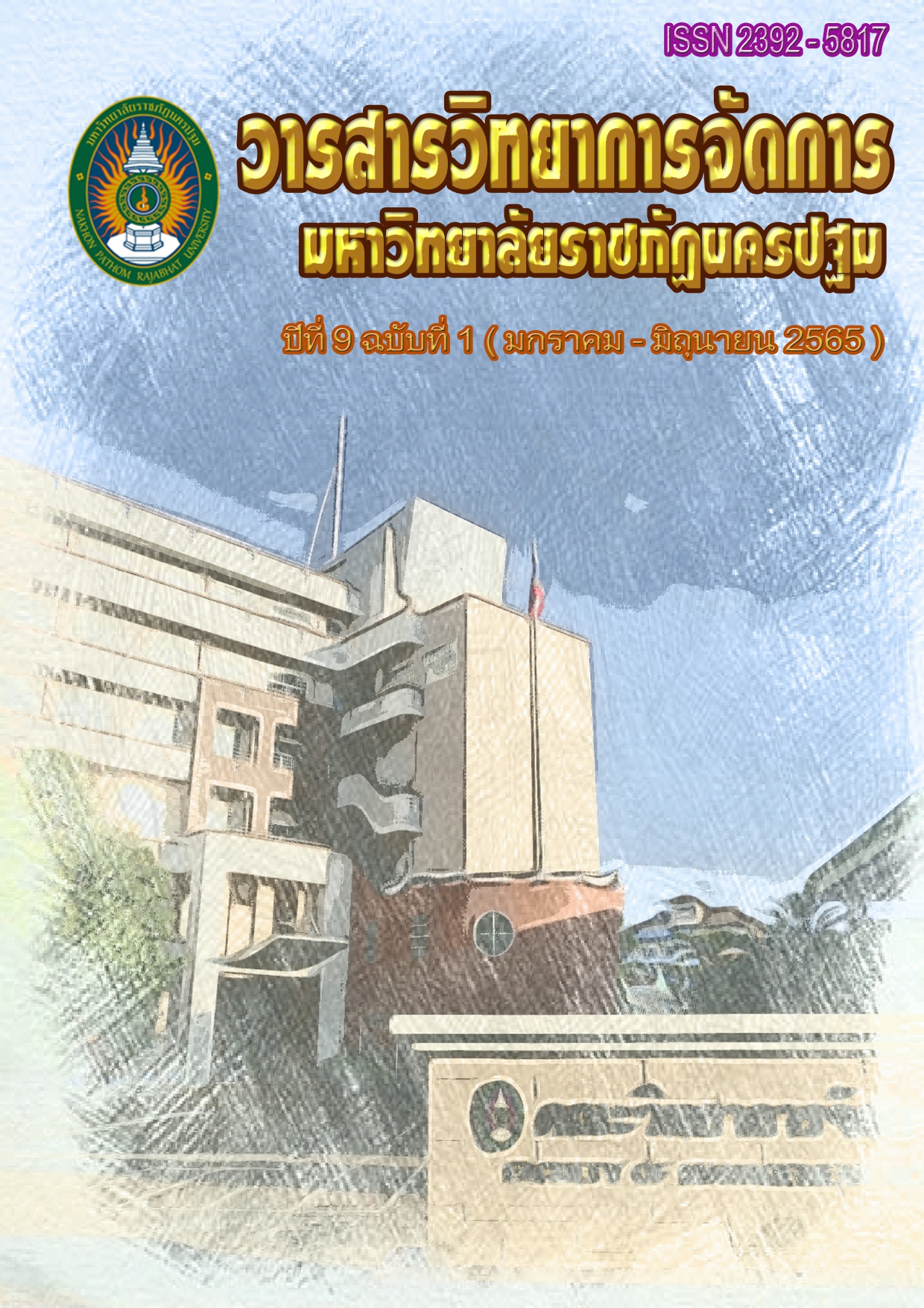เงื่อนไขความสำเร็จในการดำเนินงานวิสาหกิจเพื่อสังคม ของวิสาหกิจชุมชน ในจังหวัดสุพรรณบุรี
Main Article Content
บทคัดย่อ
การวิจัยครั้งนี้มีวัตถุประสงค์เพื่อ 1) ศึกษากระบวนการดำเนินงานวิสาหกิจเพื่อสังคมของวิสาหกิจชุมชนในจังหวัดสุพรรณบุรี 2) ศึกษาเงื่อนไขความสำเร็จในการดำเนินงานวิสาหกิจเพื่อสังคมของวิสาหกิจชุมชนในจังหวัดสุพรรณบุรี เป็นการวิจัยที่ใช้ระเบียบวิธีวิจัยเชิงคุณภาพ ผู้ให้ข้อมูลหลักได้แก่ ประธานกลุ่มวิสาหกิจชุมชน สมาชิกในกลุ่มวิสาหกิจชุมชนเกษตรอินทรีย์ทุ่งทองยั่งยืน และกลุ่มวิสาหกิจชุมชนเรือนไทยบ้านบางแม่หม้ายโฮมสเตย์ รวมถึงเจ้าหน้าที่รัฐจากสำนักงานเกษตรและสหกรณ์จังหวัดสุพรรณบุรี และเจ้าหน้าที่จากบริษัทประชารัฐรักสามัคคีจังหวัดสุพรรณบุรี ได้ผู้ให้ข้อมูลหลักทั้งหมด 10 ท่าน เครื่องมือที่ใช้ในการวิจัยเป็นแบบสัมภาษณ์แบบกึ่งโครงสร้าง และใช้การวิเคราะห์เอกสาร การวิเคราะห์ข้อมูลเชิงคุณภาพ โดยการสร้างทฤษฎี ฐานรากและการวิเคราะห์เนื้อหา
ผลการวิจัยพบว่า 1. การดำเนินงานวิสาหกิจเพื่อสังคมของวิสาหกิจชุมชนจังหวัดสุพรรณบุรี มีกระบวนการ คือ 1) การสร้างผลิตภัณฑ์เพื่อเป้าหมายทางสังคม โดยอาศัยต้นทุนในชุมชนมาสร้างเป็นผลิตภัณฑ์และบริการ 2) การสร้างความมั่นคงทางการเงิน โดยการจัดตั้งกองทุน เพื่อเป็นเงินทุนสำรองในการบริหารจัดการกลุ่ม 3) การดำเนินกิจการอย่างเป็นมิตรกับสิ่งแวดล้อม โดยการดำเนินการทุกขั้นตอนของกลุ่มคำนึงถึงเรื่องสิ่งแวดล้อม 4) การคืนผลตอบแทนสู่ชุมชนและสังคม โดยการใช้แรงงานของสมาชิกและผลิตภัณฑ์ของกลุ่ม 5) การสร้างความรู้จากชุมชน โดยผ่านรูปแบบของการถ่ายทอดจากรุ่นสู่รุ่น ผ่านกิจกรรม 2. เงื่อนไขความสำเร็จในการดำเนินงานวิสาหกิจเพื่อสังคมของวิสาหกิจชุมชนในจังหวัดสุพรรณบุรี ประกอบด้วย 1) การมีภาวะผู้นำของผู้ประกอบการ โดยการวางแผนบริหารจัดการเพื่อนำกลุ่มไปสู่เป้าหมายที่วางไว้ได้ 2) การพัฒนาผลิตภัณฑ์ให้มีความคิดสร้างสรรค์ โดยการสร้างความแตกต่างและหลากหลายให้กับผู้บริโภค 3) การบริหารจัดการที่ดี โดยการดำเนินการตามแบบแผนที่วางไว้ได้อย่างโปร่งใส และสามารถตรวจสอบได้4) การมีส่วนร่วมของชุมชนท้องถิ่น โดยที่คนในชุมชนสนับสนุนและให้ความร่วมมือกับการดำเนินการหรือกิจกรรมของกลุ่ม 5) การร่วมมือจากเครือข่าย โดยการให้คำแนะนำ ให้ความรู้ รวมถึงเงินทุนสำหรับดำเนินกิจการ 6) ผลสำเร็จจากการประกอบกิจการ โดยการแก้ปัญหาที่เกิดขึ้นในชุมชนได้ และกลุ่มมีความมั่นคง งานวิจัยนี้มีข้อเสนอแนะว่า ควรมีนโยบายมาสนับสนุน ส่งเสริมความคิดสร้างสรรค์ของ ผลิตภัณฑ์หรือบริการจากหน่วยงานต่าง ๆ ให้เป็นที่สนใจของผู้บริโภคจะช่วยแก้ปัญหาเรื่องรายได้ของคนในชุมชน และสามารถนำไปสู่การก่อตั้งกลุ่มวิสาหกิจเพื่อสังคมในชุมชน
*คณะศึกษาศาสตร์ มหาวิทยาลัยศิลปากร วิทยาเขตพระราชวังสนามจันทร์ นครปฐม 73000
1-2อาจารย์สาขาพัฒนศึกษา คณะศึกษาศาสตร์ มหาวิทยาลัยศิลปากร วิทยาเขตพระราชวังสนามจันทร์ นครปฐม 73000
Corresponding author : wanaspui@gmail.com
Article Details

อนุญาตภายใต้เงื่อนไข Creative Commons Attribution-NonCommercial-NoDerivatives 4.0 International License.
ทัศนะและข้อคิดเห็นของบทความที่ปรากฏในวารสารฉบับนี้เป็นของผู้เขียนแต่ละท่าน ไม่ถือว่าเป็นทัศนะและความรับผิดชอบของกองบรรณาธิการ
เอกสารอ้างอิง
กนกพร ฉิมพลี. (2555). รูปแบบการจัดการความรู้ภูมิปัญญาท้องถิ่นด้านหัตถกรรมเครื่องจักสาน : วิสาหกิจชุมชนจังหวัดนครราชสีมา. วิทยานิพนธ์ปริญญาดุษฎีบัณฑิต, สถาบันบัณฑิตพัฒนบริหารศาสตร์.
เกรียงไกร ทรัพย์แสนมา และสิริ ลภัสลดา ปันสาน. (2562). รูปแบบการพัฒนาสินค้าเกษตรของบริษัทประชารัฐรักสามัคคีวิสาหกิจเพื่อสังคม (ประเทศไทย) จำกัด. วารสารบริหารการปกครองและนวัตกรรมท้องถิ่น, 3 (2), 67 - 75.
ชมภูนุท จั่นนุ้ย และพินิจ ลาภธนานนท์. (2562). ความสำเร็จของวิสาหกิจชุมชนบนพื้นฐานความอยู่รอดและพอเพียง. วารสารศิลปะศาสตร์ปริทัศน์, 14 (1), 67 – 78.
ณัฐภัทร สุนทรมีเสถียร. (2552). ทุนทางสังคมกับการจัดการวิสาหกิจชุมชน : กรณีศึกษากลุ่มวิสาหกิจชุมชน ตำบลบางสน หมู่บ้านหัวนอน ตำบลบางสน อำเภอปะทิว จังหวัดชุมพร. วิทยานิพนธ์สังคมสงเคราะห์ศาสตรมหาบัณฑิต มหาวิทยาลัยธรรมศาสตร์.
ทิชากร เกสรบัว. (2556). การพัฒนาศักยภาพกลุ่มสินค้าหนึ่งตำบลหนึ่งผลิตภัณฑ์สู่วิสาหกิจขนาดกลางและขนาดย่อม กรณีศึกษา กลุ่มวิสาหกิจชุมชนแปรรูปอาหารจากกล้วย. วารสารการจัดการสมัยใหม่, 11 (2), 74 – 86.
ธงชัย พาบุ. (2552). การจัดการความรู้ธุรกิจชุมชนสุดยอดหนึ่งตำบลหนึ่งผลิตภัณฑ์. วิทยานิพนธ์ปริญญาปรัชญาดุษฎีบัณฑิตสาขา วิชาสารสนเทศศึกษา บัณฑิตวิทยาลัย มหาวิทยาลัยขอนแก่น..
ธิเดช จันทราเดช. (2546). บทบาทของธุรกิจชุมชนในการแก้ปัญหาความยากจนในชนบทในภาคเหนือของประเทศไทย. [ออนไลน์]. สืบค้นเมื่อ 28 มกราคม 2563 จาก http://dric.nrct.go.th/search/showfulltext/1/135637
นงลักษณ์ ทองศรี. (2559). รูปแบบการจัดการของกลุ่มวิสาหกิจชุมชนผลิตภัณฑ์ผ้าไหม จังหวัดบุรีรัมย์. [ออนไลน์]. สืบค้นเมื่อ 28 มกราคม 2563 จาก http://dspace.bru.ac.th/xmlui/handle/123456789/534
นพพร จันทรนำชู. (2563). พัฒนศึกษา : ความหลากหลายของกระบวนทัศน์เพื่อการพัฒนาที่ยั่งยืน. กรุงเทพฯ : วัฒนาพานิช.
ประพิน นุชเปี่ยม ติญทรรศน์ ประทีปพรณรงค์ และบงกช เจนจรัสสกุล. (2561). วิสาหกิจเพื่อสังคมในประเทศไทย : ข้อสังเกตบางประการต่อร่างพระราชบัญญัติส่งเสริมวิสาหกิจเพื่อสังคม, สำนักงานผู้ตรวจการแผ่นดิน, 11 (1), 109 -141.
ปรานี ตปนียวรวงศ์. (2560). วิเคราะห์ปัจจัยความมั่นคงทางการเงินของสหกรณ์ออมทรัพย์ในเขตพื้นที่ภาคเหนือของไทย, วารสารการจัดการธุรกิจ มหาวิทยาลัยบูรพา, 6 (2), 105 -118.
พัชรี ฉลาดธัญญกิจ. (2558). การพัฒนารูปแบบการจัดการแบบมีส่วนร่วมของผู้ผลิตผู้ทอฝ้ายที่เป็นมิตรกับสิ่งแวดล้อมในภาคเหนือตอนล่างของประเทศไทย. วารสารวิชาการมหาวิทยาลัยราชภัฏพระนคร, 6 (2), 246 – 255.
พิทักษ์พงศ์ กิตติโสภณ. (2550). การเสริมสร้างความเข้มแข็งของชุมชนภายใต้พระราชบัญญัติส่งเสริมวิสาหกิจชุมชน พ.ศ.2548 : ศึกษากรณีกลุ่มผู้ผลิตสินค้า. วิทยานิพนธ์รัฐประศาสนศาสตรมหาบัณฑิต มหาวิทยาลัยนเรศวร.
วรรณิดา สารีคำ และจันทิมา พรหมเกษ. (2562). ศักยภาพการจัดการห่วงโซ่อุปทานที่เป็นมิตรกับสิ่งแวดล้อมที่มีผลต่อการดำเนินงานของผู้ประกอบการวิสาหกิจชุมชนแปรรูปผลิตผลทางการเกษตรในจังหวัดสกลนคร. วารสารวิชาการ Veridian E-Journal, 12 (5), 1482 – 1500.
วรัทยา ธรรมกิตติภพ, พีรพงศ์ ทิพนาค และวิทยา เบ็ญจาธิกุล. (2558). กระบวนการเรียนรู้แบบมีส่วนร่วมในการจัดการธุรกิจชุมชนเพื่อสร้างความเข้มแข็งอย่างยั่งยืนของชุมชน.วารสารวิชาการมหาวิทยาลัยกรุงเทพธนบุรี, 4 (1), 200 -212.
วราภรณ์ ศรีบุญ. (2552). ปัจจัยที่มีผลต่อความสำเร็จในการดำเนินงานของผู้ประกอบการผลิตภัณฑ์ชุมชนและท้องถิ่น (OTOP) ในจังหวัดสงขลา. วิทยานิพนธ์ปริญญารัฐศาสตรมหาบัณฑิตมหาวิทยาลัยสงขลานครินทร์.
วารุณี ชินวินิจกุล. (2549). กระบวนการเรียนรู้ของชุมชนตามแนวคิดเศรษฐกิจพอเพียง : กรณีศึกษาชุมชนไม้เรียง อำเภอฉวาง จังหวัดนครศรีธรรมราช. [ออนไลน์]. สืบค้นเมื่อ 28 มกราคม 2563 จาก http://dric.nrct.go.th/index.php/Search/SearchDetail/177714
ศักดิ์ดา ศิริภัทรโสภณ. (2558). การศึกษากรอบแนวคิดเพื่อการพัฒนาวิสาหกิจเพื่อสังคมในประเทศไทย. วารสารสมาคมนักวิจัย, 20 (2), 30-45.
ศิรวิชญ์ สุประดิษฐ์. (2562). รูปแบบการดำเนินวิสาหกิจเพื่อสังคมของการท่องเที่ยวโดยชุมชนของวิสาหกิจชุมชนท่องเที่ยวบ้านแหลมสัก ตำบลแหลมสัก อำเภออ่าวลึก จังหวัดกระบี่. วารสารวิชาการ Veridian E-Journal, 12 (5), 1571 – 1584.
สันติธร ภูริภักดี. (2561). การพัฒนาองค์ความรู้สำหรับสร้างมูลค่าเพิ่มผลิตภัณฑ์เพื่อเพิ่มขีดความสามารถทางการแข่งขันแก่ผู้ประกอบการหนึ่งตำบลหนึ่งผลิตภัณฑ์ (OTOP) ในเขตจังหวัดเพชรบุรี ประจวบคีรีขันธ์ สมุทรสงคราม และสมุทรสาคร. วารสารวิชาการ Veridian E-Journal, 11 (2), 2153 – 2168.
สิริ ลภัสลดา ปันสาน. (2562). รูปแบบการจัดการธุรกิจท่องเที่ยวโดยชุมชนของบริษัทประชารัฐรักสามัคคี วิสาหกิจเพื่อสังคม (ประเทศไทย) จำกัด. วารสาร มจร. สังคมศาสตรปริทรรศน์, 8 (3), 233 - 243.
สำนักงานคณะกรรมการพัฒนาการเศรษฐกิจและสังคมแห่งชาติ. (2560). สรุปสาระสำคัญแผนพัฒนาเศรษฐกิจและสังคมแห่งชาติ ฉบับที่ 12. [ออนไลน์]. สืบค้นเมื่อ 1 กุมภาพันธ์ 2563 จาก http://www.nesdb.go.th.
สำนักงานสร้างเสริมวิสาหกิจเพื่อสังคมแห่งชาติ.(2557). แผนแม่บท สร้างเสริมกิจการเพื่อสังคม พ.ศ.2553-2557. [ออนไลน์]. สืบค้นเมื่อ 1 กุมภาพันธ์ 2563 จาก http://www.tseo.or.th/sites/default/files/se_masterplan.pdf
อนุชา ม่วงใหญ่. (2559). แนวทางการพัฒนาเพื่อเสริมสร้างศักยภาพชุมชนและท้องถิ่น “ ในศตวรรษที่ 21”. วารสารวิชาการมหาวิทยาลัยอีสเทิร์นเอเชีย, 6 (3), 12 – 25.
Brodziski, Gloria. and Village C. (2012). Economic and community development through an industrial park. Retrieved Febuary 2, 2020, from http://www.uwex.edu/ces/cced/economies/northernedge/bestpractices/marathon.cfm.
Choi, S.H. and H.H. Cheung. (2017). Multi – material virtual prototyping for product development and biomedical engineering. Computers in Industry. 58 (5), 438 – 452.
Corbin, J., and Strauss, A. (2008). Basics of qualitative research. (3rd ed.). Los Angeles, CA: SAGE.
Elkington, J. (1997). Cannibals with Forks: The Triple Bottom Line of Twenty - First Century Business. Capstone, LN: Oxford.
Emerson, J. (2003). The blended value proposition: Integrating social and financial returns. California Management Review, 45(4), 35-51.
Watson, J. (2007). Modeling the relationship between networking and firm performance. Journal of Business Venturing, 22 (6), 852 – 874.


